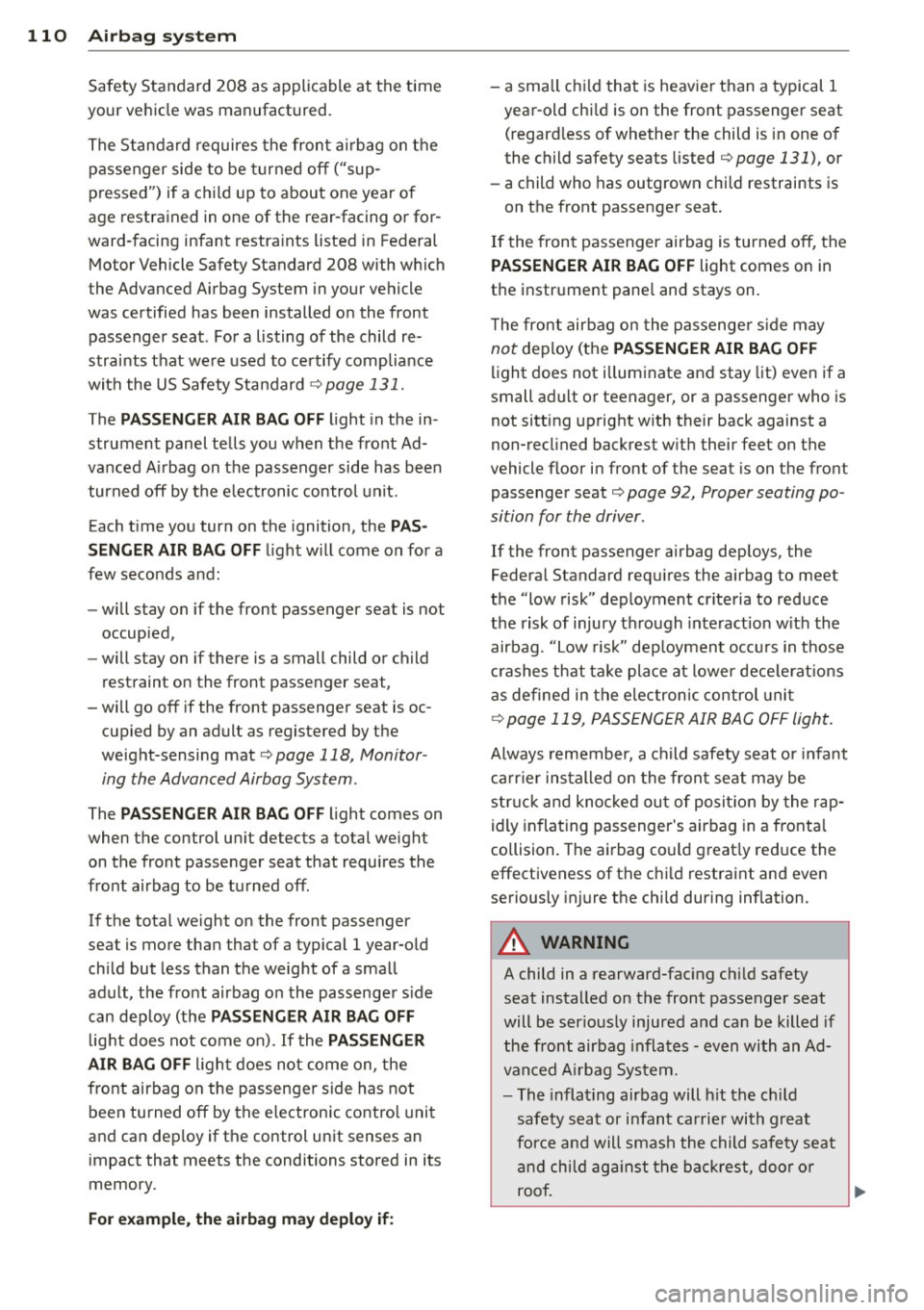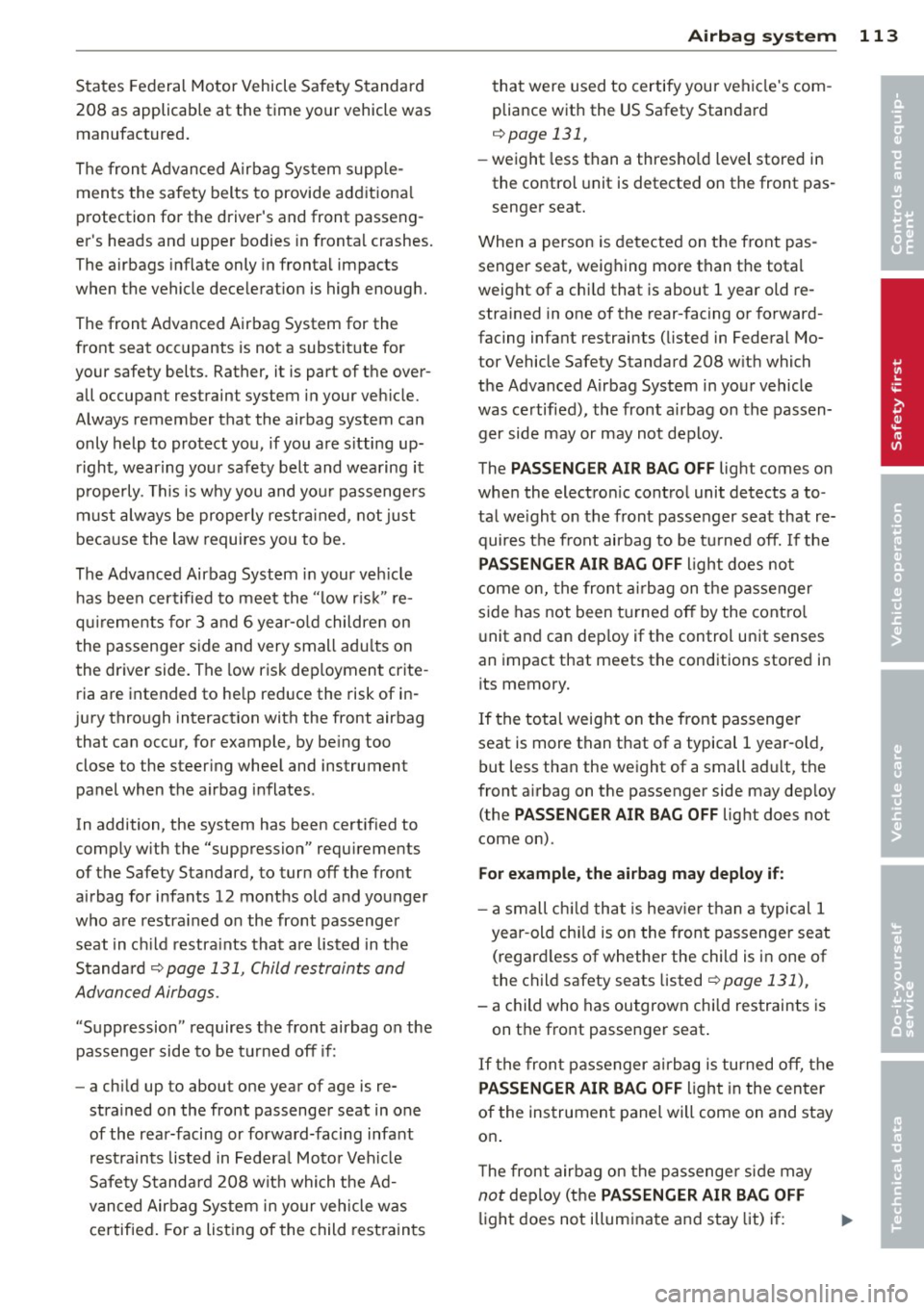seat memory AUDI TT ROADSTER 2015 Owners Manual
[x] Cancel search | Manufacturer: AUDI, Model Year: 2015, Model line: TT ROADSTER, Model: AUDI TT ROADSTER 2015Pages: 244, PDF Size: 60.74 MB
Page 112 of 244

110 Airbag sys te m
Safety Standard 208 as applicable at the time
your vehicle was manufactured.
The Standard requires the front a irbag on t he
passenger side to be turned off ("sup
pressed") if a child up to about one year of
age restrained in one of the rear-facing or for
ward -facing infant restra ints listed in Federal
Motor Vehicle Safety Standard 208 with which
the Advanced A irbag System in your vehicle
was certified has been installed on the front passenger seat . For a listing of the child re
straints that were used to certify compliance
with the US Safety Standard¢
page 131.
The PASSENG ER AIR BAG OFF light in the in
strument panel tells you when the front Ad
vanced A irbag on the passenger side has been
turned off by the e lectronic control unit.
Each t ime you turn on the ignition, the
PAS
SENGER AIR BA G OFF
light w ill come on for a
few seconds and:
- will stay on if the front passenger seat is not
occupied,
- will stay on if there is a small child or child
restraint on the front passenger seat,
- wi ll go off if the front passenger seat is oc
cupied by an adult as registered by the
weight-sensing mat
¢ page 118, Monitor
ing the Advanced Airbag System .
The PASSEN GER AIR BAG OFF light comes on
when the control un it detects a total weight
on the front passenger seat that requires the
front airbag to be turned off .
If the tota l weight on the front passenger
seat is more than that of a typical 1 year-old
child but less than the weight of a small
adult, t he front airbag on the passenger s ide
can dep loy (the
PAS SENGER AIR BAG OFF
light does not come o n). If the PASSENGER
AIR BAG OFF
l igh t does not come on , the
front airbag on the passenger side has not
been turned off by the electronic control unit
and can dep loy if the control unit senses an
impact that meets the conditions stored in its
memory .
For example , the airb ag ma y depl oy if :
- a small ch ild tha t is heav ier than a typical 1
year-old chi ld is on the front passenger seat
(regard less of whether the child is in one of
the child safety seats listed
¢ page 131), or
- a child who has outgrown child restraints is
on the front passenger seat.
If the front passenger airbag is turned off, the
PASSENGER AIR BAG OFF light comes on in
t h e instr ument pane l and stays on.
T he front airbag on the passenge r side may
not dep loy (the PASSENGER AIR BAG OFF
li ght does not illum inate and stay lit) even if a
small adult or teenager, or a passenger who is
not sitt ing upright w ith their back against a
non-recl ined backrest w it h their feet on the
vehicle floor in front of the seat is on the front
passenger seat¢
page 92, Proper seating po
sition for the driver .
If the front passenger airbag deploys, the
Federal Standard requ ires the airbag to meet
the "low risk" deployment cr iteria to reduce
the risk of injury th rough interact ion w ith the
airbag. "Low risk" deployment occurs in those
crashes that ta ke pla ce at lower dece le rat io ns
as de fined in t he electronic control uni t
¢ page 119, PASSENGER AIR BAG OFF light.
Always remember, a child safety seat or infant
ca rrier in stalled on the fron t seat may be
stru ck and knoc ked out of posit ion by the rap
idly in flat ing passenger 's airbag in a fronta l
collision. The a irbag co uld great ly red uce the
effectiveness of the ch ild restraint and even
seriously in jure the chi ld during inflation .
A WARNING
-
A child in a rearward-fac ing ch ild safety
seat installed on the front passenger seat
will be serious ly injured and can be killed if
the front airbag inflates -even with an Ad
van ced A irbag System.
- The inflating airbag will h it the ch ild
safety seat or infant carrie r with great
for ce and will smash the child safety seat
a nd child ag ai nst t he backrest, door or
roof.
Page 115 of 244

States Federal Motor Vehicle Safety Standard
208 as applicable at the time your vehicle was
manufactured.
The front Advanced A irbag System supp le
ments the safety belts to provide additiona l
protection for the driver's and front passeng
er's heads and upper bodies in fronta l crashes.
The airbags inflate only in frontal impacts
when the vehicle deceleration is high enough.
The front Advanced Airbag System for the
front seat occupants is not a substitute for
your safety belts. Rather, it is part of the over all occupant restraint system in your veh icle.
Always remember that the airbag system can
only help to protect you, if you are s itting up
right, wearing your safety belt and wea ring it
prope rly. This is why you and you r passenge rs
must always be properly restr ained , not just
because the law requires yo u to be.
The Advanced Airbag System in your veh icle
h as been certified to meet the "low ris k" re
qu irements for
3 and 6 year-o ld childre n on
the passenger side and very small adu lts on
the driver side. The low risk dep loyment crite
ria are intended to he lp reduce the risk of in
jury through interaction with the front airbag that can occur, for example, by be ing too
close to the steer ing wheel and instrument
panel when the airbag inflates.
In addition, the system has been certif ied to
comply w ith the "suppression" requ irements
of the Safety Standard, to turn
off the front
airbag for infants
12 months old and younger
who are restra ined o n the front passenger
seat in c hild restra ints that a re listed in the
Standa rd
¢page 131, Child restraints and
Advanced Airbags.
"Suppression" requires the front airbag on the passenger side to be turned
off i f:
- a ch ild up to about one year of age is re
stra ined on the front passenger seat in one
of the rear-facing or forward-fac ing infant
rest raints listed in Federa l Motor Veh icle
Safe ty S tanda rd 208 w it h which t he Ad
vanced Airbag System in your vehicle was certified . For a listing of the child rest raints
A irbag system 113
that were used to certify your vehicle's com
pliance with the US Safety Standard
¢ page 131,
-weight less than a thresho ld level stored in
the control unit is detected on the front pas
senger seat.
When a person is detected on the front pas
senger seat, weighing more than the total
weight of a chi ld that is about
1 year old re
stra ined in one of the rear-facing or forward
facing infant restraints (listed in Federal Mo
tor Vehicle Safety Standard 208 w ith which
the Advanced A irbag System in your vehicle
was certified), the front airbag on the passen ger side may or may not deploy.
The
PAS SENGER AIR BAG OFF lig ht comes on
when the electron ic contro l unit detects a to
ta l we ight on the front passenger seat that re
quires the front airbag to be tu rned
off. If the
PASSENGER AIR BAG OFF light does no t
come on, the fron t ai rbag on the passe nger
s ide has not been t urned
off by the contro l
u nit and can dep loy if the control unit senses
an impact that meets the cond itions stored in
its memory.
If the total weight on the front passenge r
seat is more than that of a typical
1 year-o ld,
but less than the we ight of a small ad ult, the
front a irbag on the passenger side may dep loy
(the
PASSENGER AIR BAG OFF light does not
come on) .
For example , the airb ag m ay deploy if:
- a small ch ild that is heav ier t han a typical 1
year -old chi ld is on the front passenger seat
(regard less of whether the child is in one of
the child safety seats listed
¢page 131),
-a child who has outgrown chi ld restraints is
on the front passenger seat .
If the fron t passenger airbag is turned
off, the
PASSENGER AIR BAG OFF light in the cen ter
of the instrument panel will come on and stay
on .
T he front airbag on the passenge r side may
not deploy (the PASSENGER AIR BAG OFF
light does not illuminate and stay lit) i f:
•
•